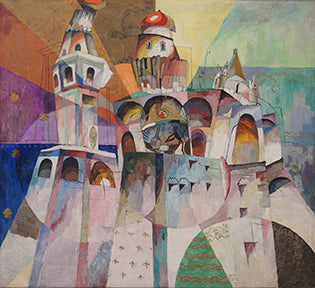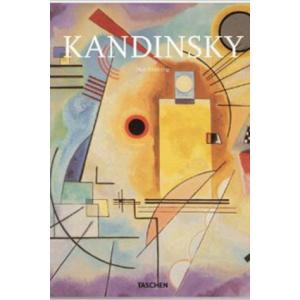The Birth of the Russian Avante-Garde
by Cathy Locke
Considered the first group of the Russian avante-garde, the Jack of Diamonds (also known as the Knave of Diamonds) started as the name of an exhibition in 1910 to 1911 held in Moscow. As an association of painters, the Jack of Diamonds, existed from 1911 to 1917. The name was first coined by Mikhail Larionov, who initiated the group’s first show and was the famous trouble maker of Russian art in the 1910s. The group consisted of painters from both Moscow and near by provinces. Most of the members were students at the Moscow School of Painting, Sculpture and Architecture. The key players in the movement were: Ilya Mashkov, Petr Konchalovsky, Aristarkh Lentulov, Alexander Kuprin, Robert Falk and Vasily Rozhdestvensky. They were all admirers of modern French painters and they frequented the house of Sergei Shchukin were they were able to study canvases by Cezanne, Van Gogh, Gauguin and Matisse.
During the 1910s Russia witnessed an artistic explosion. Young artists were turning away from the bonds of tradition, and rejecting the knowledge that they were taught. In fact all of the members of the Jack of Diamonds were expelled from the Moscow School of Painting. They felt that art needed to change so that it could express the new ideas of the changing world around them.
In the spring of 1910 an exhibition was held of the Union of Russian Painters. At this exhibition the division of styles was clear. In the middle was the World of Art group and the Jack of Diamonds were catalogued as the avante-garde. Renowned painter and art critic, Alexander Benois, said that this young group of painters had gone too far in over-throwing accepted artistic ideals. The first exhibition of the Jack of Diamonds shocked the public. It was said that the exhibition was in bad taste, clumsy, artless, and violent. Kandinsky’s “Improvisations” led to scandal. It was the first time Russia had ever experienced art consumers in such conflict with the creators of the art. Their paintings rejected the laws of perspective and life drawing. The principle of comic vision, the idea of turning the traditions and stereotypes inside out, bound the members of the group together. The image of a beautiful dame was replaced by overdressed snotty matrons. Goncharova’s and Lentulov’s religious compositions shocked audiences with their primitiveness, and they were forced to remove them from exhibition. Their painting style was not to copy reality, but to focus on the very process of painting.

Neo-primitivists and the Russian Cezannians There were two branches of the Jack of Diamonds, the neo-primitivists and the Russian Cezannians. At the beginning both branches had much in common, but as time went on their paths separated.
The Neo-primitivists were oriented to the non-classical traditions of folk art. These artists were following the path of Paul Gauguin and both Matisse and Picasso, who had incorporated primitive African art into their paintings. The Russian Neo-primitive artists were interested in art of the everyday. Their goal was to “educate the eye,” to teach the contemporary audience to understand a new meaning behind what was beautiful. In fact, Larionov’s creativity in this movement lead him to the invention of Rayonism in 1912, which was the first art movement to first bring art to the discovery of non-figurative work.
The Russian Cezannians were studying the painterly qualities of weight, mass and texture. They were experimenting with ways of modeling form. Paul Cezanne became their chief mentor, with additional influences of Cubism. Where as the canvases of the Neo-primitivists were painted with loud colors, the Cezannians worked with analogous color palettes.
By 1913 the Jack of Diamonds had split into several branches to explore new directions in theory. These sub-movments included: Rayonism, Orpheism, Cubism, Futurism and others. They all organized their own separate exhibitions which included names like the “Donkey’s Tail” and “Target.” Simultaneously the main group invited celebrities such as Pablo Picasso, Henri Rousseau, Paul Signac, Robert Delauney and Fernand Legar to exhibit with them.
The Jack of Diamonds had their last group exhibition in 1914. Among the participants were representatives of the “extreme” left – Vladimir Tatlin, Kazimir Malevich, Lyubov Papova and Nadezhda Udaltsova – who had all joined the association. Art critic, Abram Efros, said in his review of their 1914 exhibit that the group had made its viewers understand art better. He went on to say “They include portrayal of the material world of objects for which their originally simple forms would be their natural shell. Another big theme is a landscape of simple geometric compositions. The ‘Jacks’ have mostly found harmony, for the simplicity of their pictorial forms corresponds to the simple form of what they portray.”
The Jack of Diamonds stopped at the threshold of Suprematism. The works of Konchalovsky, Mashkov, Lentulov, Kuprin and Falk all found their way into international museums and private collections. The Jack of Diamonds had carried out a special mission in art by making Russian painting closer to the French artistic culture. They had a profound influence on Russian modern art.
About the Author
Cathy Locke is an award-winning fine art painter, professor, and published writer, specializing in Russian art of the 19th and 20th centuries. She organizes annual art excursions to Russia and is the editor of Musings-on_Art.org.
Russian Art Tour: www.russianarttour.com
Cathy’s artwork: www.cathylocke.com














